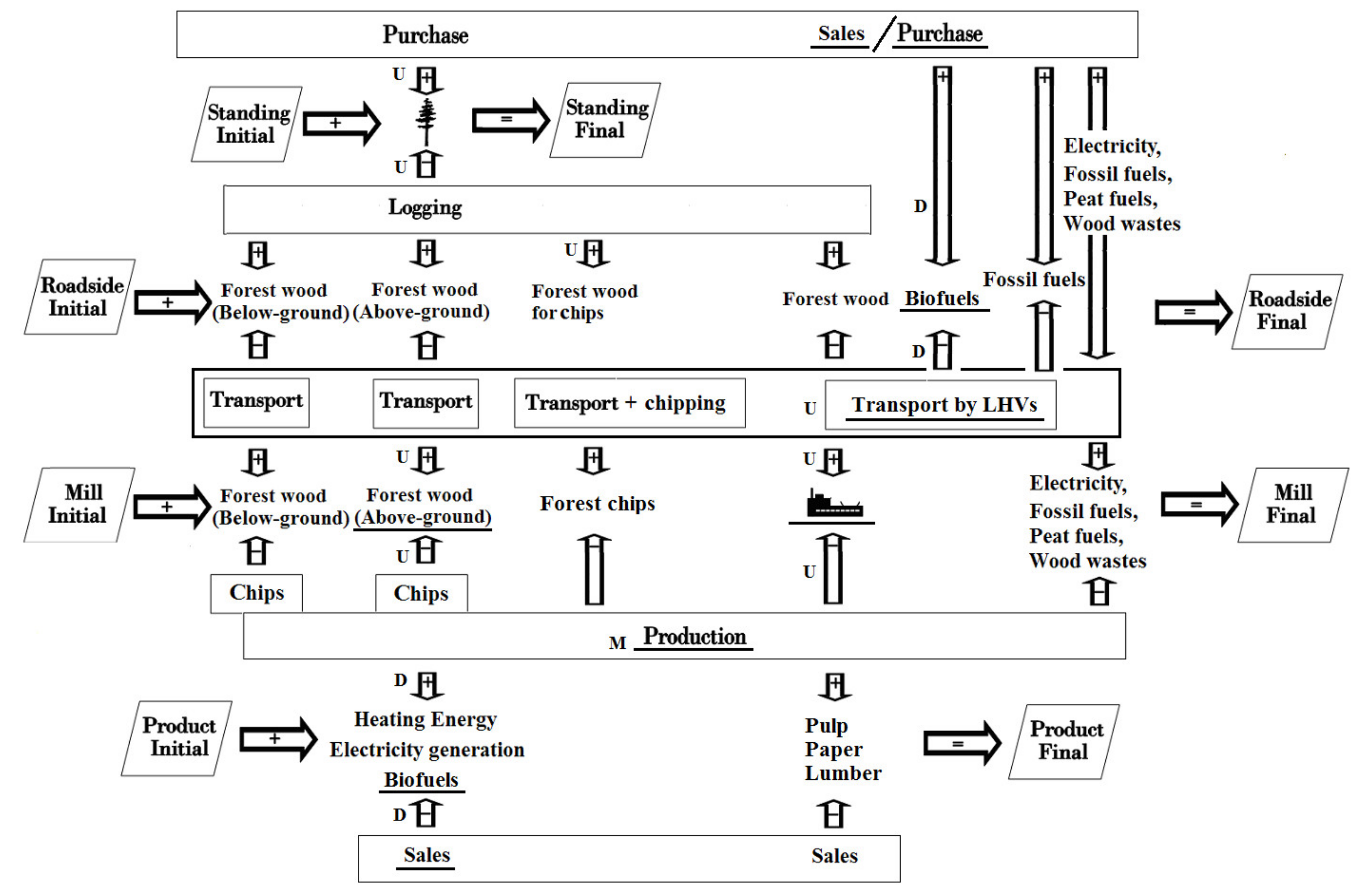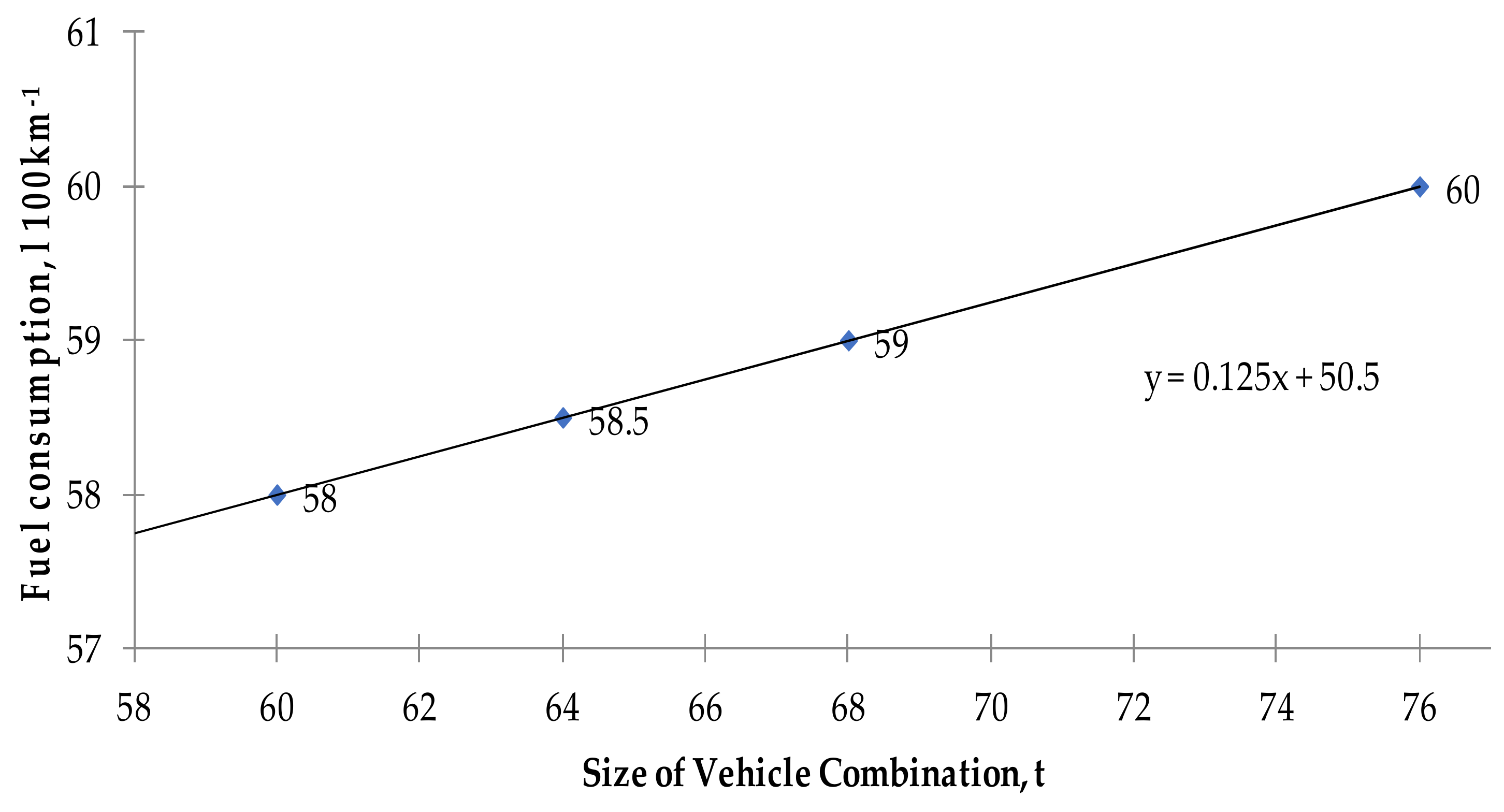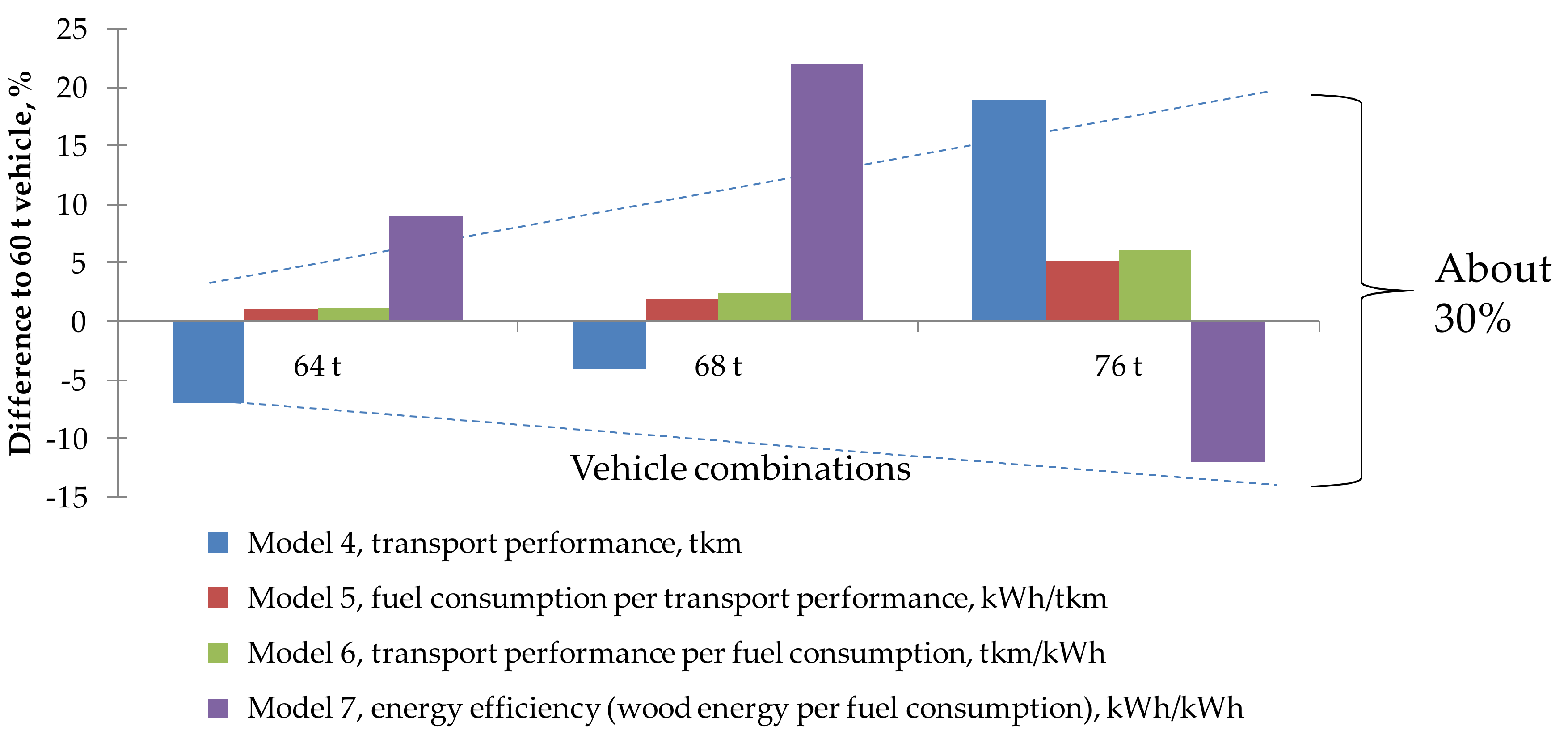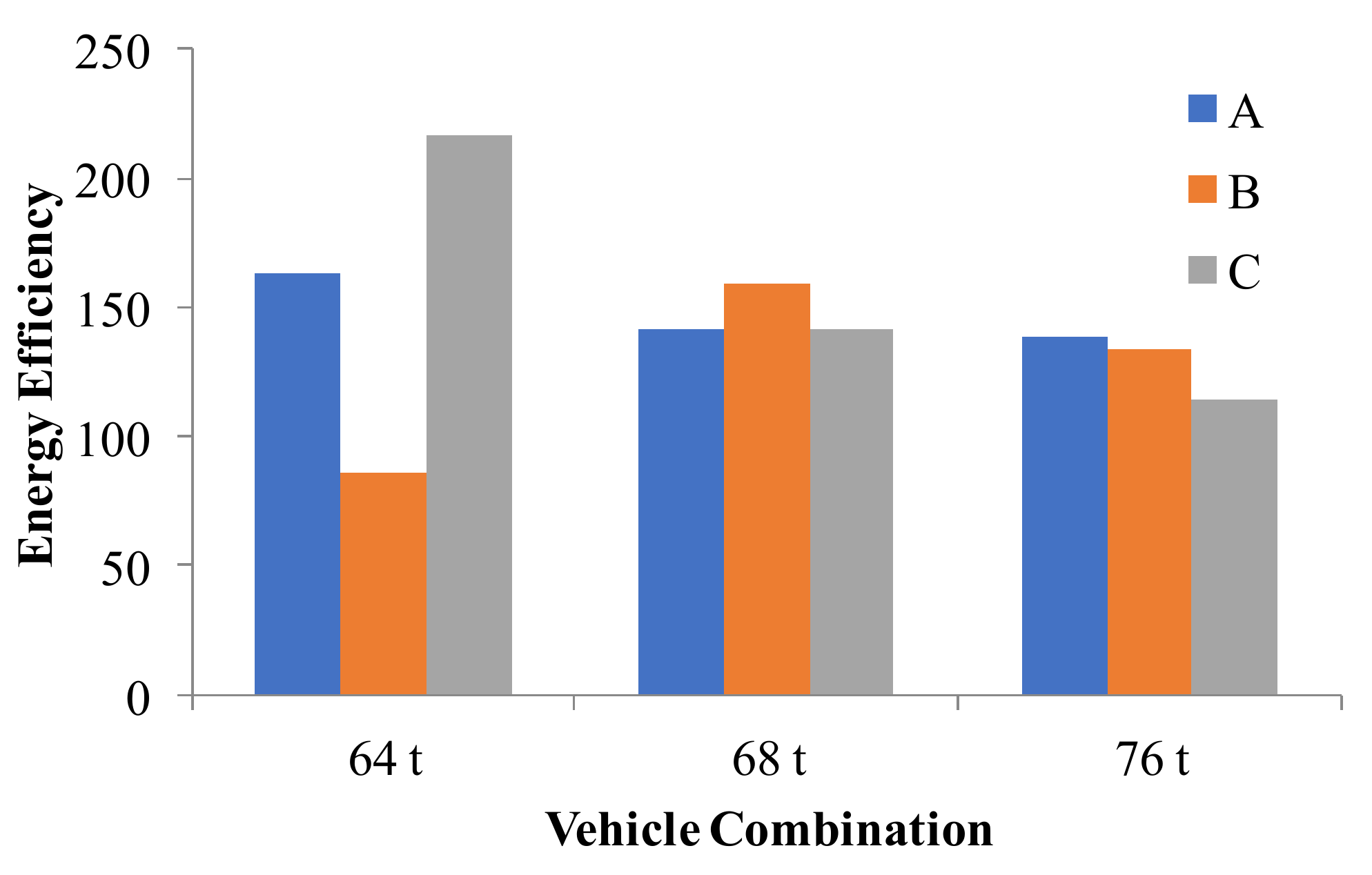4. Discussion and Future Research
The energy efficiency models of STS were tested for improving the environmental sustainability of road freight transportation. The main focus of the tests was to select the most robust indicator from four energy efficiency models [
65,
66,
67,
68] for development of carbon-neutral transportation fleets that included 60, 64, 68, and 76 t vehicle combinations. The indicator will be used in ecosystem modeling of “green” circular industry (
Figure 2). As the energy consumed by trucks corresponds to the trend in liter-based fossil fuel consumption, the models were converted to match the common energy consumption unit (kWh) [
44,
45]. Besides fossil fuel, biofuel consumption could also be taken into account in calculations and ecosystem modeling [
11].
Table 8 shows that the natural renewable wood resource-based energy efficiency measure (Model 7) was the most accurate and precise development indicator. Model 7 defines this energy efficiency indicator that accounts for relationships between a payload’s 100% renewable wood energy and a vehicle’s fossil fuel consumption. Comparing indicator values in different loads of vehicle combinations among themselves reliably showed differences. In summary, the novel Model 7 (load’s renewable wood energy/fossil transport energy) is recommended for more common use as a robust measure in transportation statistics, planning and related fields for environmentally sustainable development. As an example, it was applied in Nordic transportation conditions.
The indicator revealed that the road freight transportation systems (60, 64, 68, and 76 t) and (64, 68, and 76 t) were carbon negative both in the northern (122, 133, 144, and 108) and the eastern study area (142, 147, and 133), respectively. The calculations compared the energy efficiency of heavier vehicle combinations to the 60 or 64 t vehicle combinations as it is important to investigate how much the maximum permissible mass increase of the vehicle combination affected energy efficiency. In the eastern study area, vehicle combinations 64, 68, and 76 t without 60 t were used in the fleet in 2016, since the three-year adaptation process from 2014 shifted the fleet toward larger and heavier vehicles (LHVs). Therefore, 64 t vehicles instead of 60 t were used in efficiency comparisons in the eastern study area. The use of 68 t vehicles increased energy efficiency most effectively in both regions, respectively, by 18.0% and 20.5%. However, 76 t vehicles were not so successful, at −11% and −3.9%, respectively. The most efficient 76 t vehicles operated in wood supply region A by producing an energy efficiency value of 139.8 for laden vehicles in 2016 (
Figure 10), which means an efficiency increase of 29.4% compared to the 2014 level (
Table 5). There were clear and quite large ranges in energy efficiencies between the partial transportation regions (A, B, and C) of the eastern study area (
Table 7 and
Figure 10). Consequently, the indicator also revealed that the energy efficiency of the STSs is dependent on regional transportation conditions. If we take a careful look at the research area map (
Figure 5), there are great differences in the regions’ road networks. In addition, there are differences in plant numbers as possible transportation destinations. Together, these conditions affected vehicle routing, optimization, and scheduling alternatives of transportation fleets. In this respect, the indicator enables transportation entrepreneurs to plan loads and manage their vehicles in the selected area in the most energy efficient way.
Although several studies have suggested that the use of RES and renewable products can mitigate climate change [
46], utilization of studies in practice has been difficult due to the different and unspecified analytical frameworks of energy efficiency measurements. It is clear that industrial supply networks are too complex to solve by simulation models [
11]. Apart from simulation, in utilizing optimization frameworks the quantity value (energy relation between the renewable wood resource and fossil fuel consumption)-based energy efficiency measure (Model 7) could be recommended to indicate the attained energy efficiency level of the STS and LHVs for analytical reformulation on ecosystem optimization models. On the other hand, efficiency can often be expressed as a percentage of the result that could ideally be expected in some studies [
42,
46], but in wood supply networks’ transport freight operation, efficiency was better to quantify with a non-percentage value. So, the used energy efficiency analysis provided a plausible measurement framework and novel insights into the relationships of transportation conditions and the transportation fleet combinations. It seems that, using energy efficiency information provided by the indicator (Model 7) for formulation of parameters and variables of industrial ecosystem model (
Figure 2), the carbon neutrality of vehicles and environmental sustainability of transportation could be optimized (not simulated) in separate transportation regions in which fleets are adapted to the larger mass limit.
The indicator confirmed that during the three-year adaptation process of road transportation fleets there has been a remarkable increase in energy efficiency of the STSs. This means that environmental sustainability of road transportation was improved during the adaption period from 2014 to 2016. The indicator also confirmed the assumption that fleet-management methods are needed to achieve all of LHV’s benefits in wood transportation fleets and supply networks. These results are consistent with previous studies [
20,
50]. In addition, the results are plausible and they can be generalized consistently, because they are based on the analyzed real-world RES data of a large global forest industry company (
Figure 1). The company actually delivered one-third of used wood resources to mills (23 million m
3) per year in Finland [
11,
48].
The data of wood supply and procurement organizations were collected (data-mining) from practice (ERP systems) about wood delivery from selected transportation regions to their plant destinations. The material was big digital data, which provided reliable calculation of results and analysis to the study aims. Researchers selected three geographical regions, which consisted of different transportation conditions (e.g., both effective and ineffective logistics networks). These are matters for discussion that need to be tackled more carefully. If the energy efficiency of region C is considered,
Figure 5 shows that it is near the Russian border, where the road network was ineffective for LHVs. Clearly, the transportation effectiveness of this region also depended on plant locations because the number of plants was four instead of nine or six, as in regions A and B, respectively. Regions A and B were more effective than C, and together, the regions were used successfully to reveal the impacts of the different transportation conditions on the benefits of LHVs in “high-capacity transportation” (
Table 6 and
Table 7,
Figure 10). Clearly, the data collection was planned carefully and the received results appear logical, which also comes from used physics and clear mathematical reasoning of calculation [
43,
58]. In this respect, it is evident that the wood resource-based energy efficiency measure (Model 7) is consistent and most useful in operations research analysis with 100% renewable wood (
Figure 1). This is novel knowledge compared to previous studies [
28,
29,
52,
54]. However, more comprehensive logistics data analysis is needed about an adaptation process to solve, for example, backhauling alternatives with several clients for more comprehensive supply-network analysis [
10]. Besides, at least minimization of empty-load driving of vehicles would be useful to take into consideration in routing and supply-network optimizations (
Figure 4). Otherwise, with the bounded regional material of this study alone, the energy efficiency discussion might focus more on the inbound logistics of forest industry companies without valuable full collaboration and support of entrepreneurs (contractors) for the development of the industrial ecosystem model [
11,
61].
The research presented here draws upon data that is a representation of the homogenous road transportation situation in Nordic countries. Key threats to the validity of generalized inferences in operations research are that specific findings with restricting assumptions cannot be guaranteed to be appropriate to regions outside of the scope of the studies [
24,
47]. On the other hand, there is no technical problem for the use of this measure in transportation situations of other countries or smaller percentages (<100%) of renewable wood (
Figure 1). Correspondingly, researchers, officials, and stakeholders of other forest- and “green” industry companies abroad can similarly apply the natural (wood) resource-based energy efficiency indicator to their transportation conditions [
24,
36]. Besides the robust efficiency measurement framework, the environmental sustainability of the transportation operations could be optimized by multi-objective models in the future with respect to varying energy efficiency parameters (criteria) instead of assumptions (constants) as some studies have suggested [
11,
24]. Accordingly, the wood flow from forest to mills (upstream) could be balanced with respect to multiple criteria to ensure the decarbonization target of the EU in economically and environmentally sustainable supply networks which have been deemed necessary in green industry. This kind of approach was suggested by Kostevšek et al. [
36] in an energy production (midstream) context. In this same framework, the review by Butturi et al. [
33] represents a first synthesis of the knowledge in the fields of energy symbiosis, eco-industrial parks, and renewable energy sources. Recently, Palander et al. [
11] applied green circular optimization model for circulating 100% renewable wood from forest to biofuel of wood transportation vehicles. The model circulates upstream, midstream, and downstream of the industrial ecosystem, which can be expanded by results of literature and this study.
Based on these research results, some practical answers can be suggested to policy makers’ climate concern as steps toward sustainable forest industry [
5,
9]. In regard to energy efficiency of road transportation (as an example about supply networks’ operations), the goals to create a 100% carbon-neutral base can be implemented in the forest industry utilizing renewable forest resources [
9]. There is no question that LHVs go at least some way towards alleviating carbon neutrality concerns. Even carbon-negative operations already happen in the forest industry’s green circular economy [
2,
3]. However, the consistency of conclusions is questionable if the share of 100% renewable wood will decrease in the future (
Figure 1). Unfortunately, this problem is possible in any country if forest wood harvesting is limited for the sake of short-term public benefits of a carbon sink policy. A lot of trees might die due to the lack of harvesting or due to forest fires pumping carbon into the climate, which are also warming the climate, accelerating climate change, and causing shorter rotation of forest life. Therefore, intensive wood harvesting and silvicultural operations should be increased in forestry to secure the vital carbon sink of forests, e.g., for its 50-years rotation of balanced forestry (
Figure 1). Since forests are the main absorber of carbon, sustainable forest management is undoubtedly necessary to adapting and achieving climate goals.
5. Conclusions
Forest industry provides renewable products and can address their environmental sustainability burdens by developing logistics operations. This study developed energy efficiency indicators for carbon-neutral transportation. The wood-based energy efficiency measure (payload’s renewable wood energy/fossil transport energy) was the most robust model as the development indicator. The indicator showed that fleets of synchronized transportation system (60, 64, 68, and 76 t) and (64, 68, and 76 t) were actually carbon negative (122, 133, 144, and 108) (142, 147, and 133) in 2014 and 2016, respectively (value of 1 means a carbon-neutral transportation). These positive effects (in terms of the energy efficiency measures) of a three-year adaptation process were calculated in the transportation systems with 100% renewable wood supply from different raw-material procurement regions to production. In addition to significant advance in the adaptation of fleets, the indicator revealed that the energy efficiency of the system is dependent on regional transportation conditions. This novel knowledge about the effects of supply regions can be utilized to advance the adaptation further in transportation fleets, e.g., toward larger and heavier vehicles. In addition, the indicator enables transportation entrepreneurs to plan loads and manage their vehicles in the selected area in the most energy efficient way.
The energy efficiency measurement framework will provide development potential of optimization tools for improving carbon neutrality of transportation fleets. The proposed framework has great technical potential for balancing operations of renewable raw-material logistics in the industrial ecosystem. In summary, the integration of physics principle of Model 7 with the multiple-objective optimization framework could advance design of decision-making systems for improving decarbonization and environmental sustainability development in the green circular industry. The proposed framework will enhance the sustainability performance of the industrial ecosystem addressing its three aspects (i.e., economic, environmental, and social performance). The companies, researchers, officials, and other stakeholders abroad can similarly apply the resource-based energy efficiency indicator, although it would be possible to use only a smaller percentage (<100%) of renewable raw material in their non-balanced industrial operation environments.

















